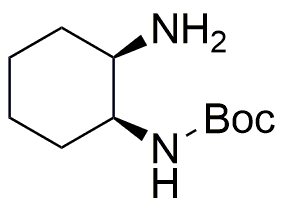(1S,2R)-N1-(tert-Butoxycarbonyl)-1,2-cyclohexanediamine is widely utilized in research focused on
- Pharmaceutical Development: This compound serves as an important intermediate in the synthesis of various pharmaceuticals, particularly in the development of drugs targeting neurological disorders due to its ability to cross the blood-brain barrier.
- Peptide Synthesis: It is commonly used in peptide synthesis as a protecting group for amines, allowing for the selective modification of amino acids without affecting other functional groups, which is crucial in the production of complex peptides.
- Material Science: The compound finds applications in the development of polymeric materials, enhancing properties such as flexibility and thermal stability, making it valuable in industries like automotive and aerospace.
- Bioconjugation: Its reactive functional groups enable bioconjugation techniques, facilitating the attachment of biomolecules to surfaces or other molecules, which is essential in drug delivery systems and diagnostic applications.
- Research in Organic Chemistry: This chemical is a useful reagent in organic synthesis, allowing researchers to explore new reaction pathways and mechanisms, thus contributing to advancements in synthetic methodologies.
General Information
Properties
Safety and Regulations
Applications
(1S,2R)-N1-(tert-Butoxycarbonyl)-1,2-cyclohexanediamine is widely utilized in research focused on
- Pharmaceutical Development: This compound serves as an important intermediate in the synthesis of various pharmaceuticals, particularly in the development of drugs targeting neurological disorders due to its ability to cross the blood-brain barrier.
- Peptide Synthesis: It is commonly used in peptide synthesis as a protecting group for amines, allowing for the selective modification of amino acids without affecting other functional groups, which is crucial in the production of complex peptides.
- Material Science: The compound finds applications in the development of polymeric materials, enhancing properties such as flexibility and thermal stability, making it valuable in industries like automotive and aerospace.
- Bioconjugation: Its reactive functional groups enable bioconjugation techniques, facilitating the attachment of biomolecules to surfaces or other molecules, which is essential in drug delivery systems and diagnostic applications.
- Research in Organic Chemistry: This chemical is a useful reagent in organic synthesis, allowing researchers to explore new reaction pathways and mechanisms, thus contributing to advancements in synthetic methodologies.
Documents
Safety Data Sheets (SDS)
The SDS provides comprehensive safety information on handling, storage, and disposal of the product.
Product Specification (PS)
The PS provides a comprehensive breakdown of the product’s properties, including chemical composition, physical state, purity, and storage requirements. It also details acceptable quality ranges and the product's intended applications.
Certificates of Analysis (COA)
Search for Certificates of Analysis (COA) by entering the products Lot Number. Lot and Batch Numbers can be found on a product’s label following the words ‘Lot’ or ‘Batch’.
*Catalog Number
*Lot Number
Certificates Of Origin (COO)
This COO confirms the country where the product was manufactured, and also details the materials and components used in it and whether it is derived from natural, synthetic, or other specific sources. This certificate may be required for customs, trade, and regulatory compliance.
*Catalog Number
*Lot Number
Safety Data Sheets (SDS)
The SDS provides comprehensive safety information on handling, storage, and disposal of the product.
DownloadProduct Specification (PS)
The PS provides a comprehensive breakdown of the product’s properties, including chemical composition, physical state, purity, and storage requirements. It also details acceptable quality ranges and the product's intended applications.
DownloadCertificates of Analysis (COA)
Search for Certificates of Analysis (COA) by entering the products Lot Number. Lot and Batch Numbers can be found on a product’s label following the words ‘Lot’ or ‘Batch’.
*Catalog Number
*Lot Number
Certificates Of Origin (COO)
This COO confirms the country where the product was manufactured, and also details the materials and components used in it and whether it is derived from natural, synthetic, or other specific sources. This certificate may be required for customs, trade, and regulatory compliance.


